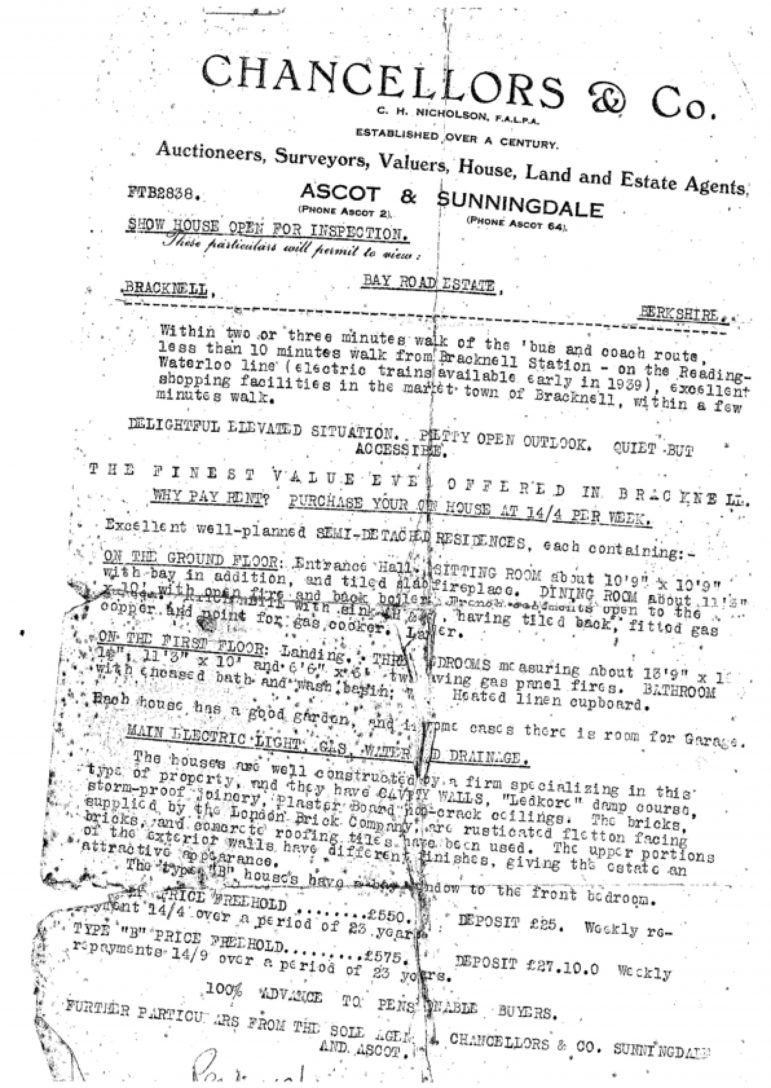When a member of the public handed in some old property details dating back to the 1930s after clearing out her loft, staff at Chancellors were quick to get out their calculators.
The details, which were handed in to the firm’s branch in Hemel Hempstead, advertised a couple of three-bed semis in Bracknell, Berkshire.
Eighty years or so ago, one could be bought for £550 (£25 deposit and weekly repayments of 14 shillings and 4d – about 80p in today’s money – over 23 years); the other was £575 (£27.10s deposit, plus weekly repayments of 14 shillings and 9d over 23 years).
Translated into today’s money, the deposits would be £1,672 and £1,806 respectively with the freehold prices being £36,803 and £38,476.
Today, three-bedroom semis in Bracknell on Rightmove generally seem to have asking prices around the £500,000 mark.
So in today’s money those homes were a bargain – although no doubt at the time, the buyers felt as though they were pushing the boat out.
However, the bit we like most about these old particulars is the one- and two-digit phone numbers for the branches. How much would they be worth if only you could buy them now?



Charming bit of history – and a reminder of the corrosive madness that infected property prices from the 1970s onwards.
You must be logged in to like or dislike this comments.
Click to login
Don't have an account? Click here to register
A 3 bedroom semi in Bracknell for £500,000? Have I time travelled to the year 2069? They were £350,000 when I went to bed last night…
You must be logged in to like or dislike this comments.
Click to login
Don't have an account? Click here to register
The 1930s were one of the most fascinating decades in British history. It was the start of the most massive speculative, residential development the country has ever seen with tens of thousands of the ubiquitous semi being built over hundreds of thousands of acres from the Surrey Hills to just about every town and village in England and Wales. Because of the almost total lack of planning restrictions and the emergence of cheap credit, supply fast outstripped demand and houses were cheap, cheap, cheap! The Town & Country Planning Act in 1947 put an emergency stop to all this. The Act was necessary to prevent most of the country becoming a suburban sprawl and was one of the most successful pieces of legislation ever to pass the statute book in this respect, but it was the beginning of demand outstripping supply and the housing market we have today.
You must be logged in to like or dislike this comments.
Click to login
Don't have an account? Click here to register
Agreed. But even today just a bit over 2.5% of the land is built on according to this piece in 2012. It’s a tiny proportion.
https://www.bbc.co.uk/news/uk-18623096
There is plenty of land to build on but the will is not there and policy and nimbyism would make it impossible to repeat the wildfire development of the 1930s. Unfortunately.
You must be logged in to like or dislike this comments.
Click to login
Don't have an account? Click here to register